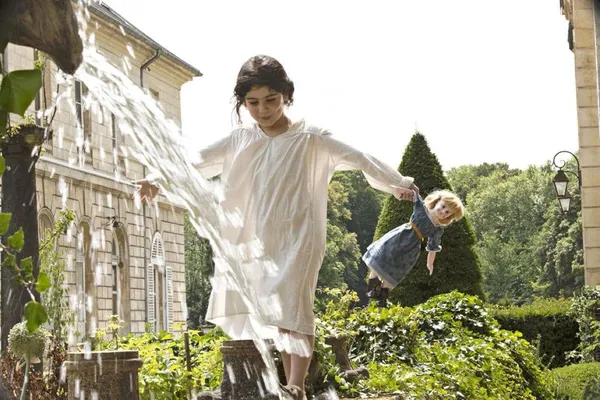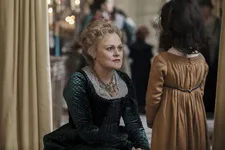 |
| Caroline Grant as Sophie de Réan in Christophe Honoré's marvelous gem Sophie’s Misfortunes |
Little Sophie (Caroline Grant) who lives in a château with her mother, Madame de Réan (Golshifteh Farahani) is an explorer with endless curiosity and a stubborn streak. Some parents might find her dangerous. Children won't. She is closer to Hayao Miyazaki heroines than Disney princesses. Sophie's Misfortunes (Les Malheurs De Sophie) co-written with Gilles Taurand (Katell Quillévéré's medical thriller Réparer Les Vivants) is Christophe Honoré's inciting take on the Comtesse de Ségur's 1858 children's book classics.
 |
| Madame Fichini (Muriel Robin) with Sophie: "I think that this mother is the one that Sophie most resembles." |
Sophie's cousin Paul (Tristan Farge) and her pals Camille (Céleste Carrale) and Madeleine (Justine Morin), daughters of the almost too perfect Madame de Fleurville (Anaïs Demoustier) accompany her on their misadventures. Madame Fichini (Muriel Robin) is the perfect evil stepmother.
Honoré, while keeping a peacock and a kitten real, decided to animate some of the other critters that populate this story. It is an inspired solution to address children's cruelty, speak of life and death, and use cartoon immortality to take the sting out of the issue at the same time. Childhood boredom - lazy summer afternoons where the imagination floats over the grass and silly ideas are hatched - has never been presented as astutely on film.
Anne-Katrin Titze: I wanted to ask you about the mothers. There is the theory that having the evil stepmother and the good dead mother - splitting the mother in half, so to say - allows children to deal with their own mother as both good and bad. And that this can be cathartic for them. You have that here even with three mothers.
CH: That's something that is very powerful in the Comtesse de Ségur. It doesn't come from me. And I think you are absolutely right. I think the novelistic fictional power of Sophie is in the fact that she has several mothers. And I think that's the secret of the success of Ségur's books with children to this day.
_225.webp) |
| Christophe Honoré with Anne-Katrin Titze for Les Bien-Aimés (Beloved) Photo: Charlie Olsky |
Now, we know very well that there are many adoption stories in fiction for children. But this is more complex because we have a trinity of mothers. We have the absent mother, who is the real mother. We have the loving mother, Madame de Fleurville, who is nearly an imaginary character. And then we have the terrible mother, Madame Fichini. And I think that this mother is the one that Sophie most resembles.
AKT: That's very interesting.
CH: One can even say that in a sense, Sophie's most real relationship is with Madame Fichini. At the end, for instance, we see that Madame Fichini hopes that Sophie will kiss her and we see that Madame Fichini suffers because Sophie does not love her. I like that very much. And the fact that Sophie can express that she doesn't love her mother - this is something that is very, very powerful in fiction about such young children.
AKT: The music reminded me in the best, most loving sense of Seventies children's programs. There was a Czech series called Pan Tau, I loved.
CH: Yes. I really wanted to work with this. With the idea of the music I liked when I was a child.
 |
| Christophe Honoré on why the animals were animated: "The problem is the animal trainers because they always promise you stuff ..." Photo: Anne-Katrin Titze |
AKT: That's what I thought.
CH: I don't know if you remember, just at the beginning, the logo Gaumont - it is not the logo Gaumont of today.
AKT: Yes, I saw it was an older one.
CH: The one when I was a child and I went to the cinema, I'd see this logo. I try in the movie, of course, to do a movie for kids for today. For my daughter who is a kid today. But also, I wanted to be faithful to my own childhood. And everything that you're talking about, the boredom and so on - all that comes also from my own childhood in Brittany. I stole a lot, I lied a lot, so it's also a very personal film and I really projected myself on the character of this little girl.
At last Saturday's Rendez-Vous with French Cinema public screening Q&A for Sophie’s Misfortunes, moderated by Florence Almozini of the Film Society of Lincoln Center, Christophe and I reconnected first through the following exchange:
Anne-Katrin Titze: When you were here with Métamorphoses, you told me you had great trouble...
Christophe Honoré (from the stage at the Walter Reade Theater): Anne-Katrin! How are you?
AKT: Hi! You said then that you had great trouble working with animals. Is that one of the reasons why you had them animated in this one?
 |
| Christophe Honoré on Sophie: "She has a very different relationship to animals than our contemporary relationship." |
CH: Exactly! It was a nightmare. It's very famous that cinema animals are something terrible. Of course it's not the animals themselves because animals are adorable. The problem is the animal trainers because they always promise you stuff that you don't actually get on the shoot. So when I started talking to my producer [Philippe Martin] about The Misfortunes Of Sophie, I realised quite quickly that there would be a lot of animals. And it was very, very clear, very, very fast that I did not want to have live animals.
And the second thing about using animation for the animals is that Sophie tortures and kills animals. She has a very different relationship to animals than our contemporary relationship. Her relationship is really violent and it's through that violence with the animals that she confronts the idea of death and also that we have a foreshadowing of the death of her mother.
So I thought it was very interesting to work with a metamorphosis of the animals in a sense through animation to avoid a kind of realism that I think might have been a little too delicate for children.
Coming up - Christophe Honoré on the dawn belonging to children, Comtesse de Ségur, Jean Vigo's Zéro de conduite, getting rid of bad over-complicated ideas, and how Sophie’s Misfortunes is not Toy Story.
The uniFrance and Film Society of Lincoln Center's 22nd edition of Rendez-Vous with French Cinema in New York, runs through March 12. Screenings will take place at the Walter Reade Theater, Lincoln Center.
























